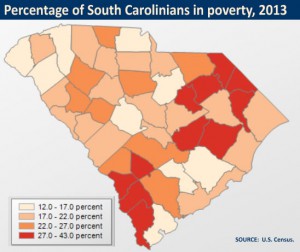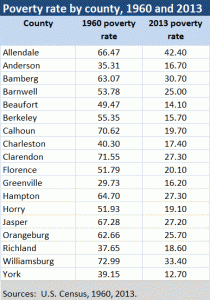Staff reports | The South isn’t as mired in poverty as it once was, according to a new report, and South Carolina is no exception. But in many places in the Palmetto State, things still aren’t that great.
Before President Lyndon Johnson launched his War on Poverty campaign, the South was home to 49 percent of the nation’s poor, according to Pew Research. Today, the region is home to 41 percent of the nation’s poor. But what’s striking is how poverty overall is far different throughout the South.
 Back in 1960, some 35.6 percent of Southerners lived in poverty, compared to 16.4 percent today, the report said. South Carolina is no different. In 1960, 45.4 percent of South Carolinians lived in poverty, according to census information. Today, 18.5 percent of people in the Palmetto State live at or below the poverty level.
Back in 1960, some 35.6 percent of Southerners lived in poverty, compared to 16.4 percent today, the report said. South Carolina is no different. In 1960, 45.4 percent of South Carolinians lived in poverty, according to census information. Today, 18.5 percent of people in the Palmetto State live at or below the poverty level.
Nationally, poverty has shifted from a more rural occurrence to a more urban one, the Pew report said. But that’s not the case in South Carolina. The chart below of selected counties illustrates how poverty fell across the board in South Carolina’s counties, but rates tend to be much lower in urban counties or in neighboring suburban counties.
 Case in point: Calhoun County, once a rural mainstay that now more of a suburban county wedged between larger communities of Columbia and Orangeburg. Back in 1960, Calhoun County had a 70.6 percent poverty rate. Today? It’s still high, but is 19.7 percent.
Case in point: Calhoun County, once a rural mainstay that now more of a suburban county wedged between larger communities of Columbia and Orangeburg. Back in 1960, Calhoun County had a 70.6 percent poverty rate. Today? It’s still high, but is 19.7 percent.
Coastal counties that have gotten huge influxes of tourism and growth also had big drops — 51.9 percent (1960) to 19.1 percent (2013) for Horry County. Beaufort County went from 49.5 percent poverty in 1960 to 14.1 percent in 2013. Charleston County dropped from 40 percent to 17.4 percent.
But the story hasn’t changed much in places like Allendale County. In 1960, two in three people lived in poverty. In 2013, 42.4 percent of its residents lived below the poverty level. Today, it’s one of the most impoverished counties in the nation.
Across the state, some 35 of 46 counties today have poverty rates above South Carolina’s already higher-than-national poverty rate of 18.5 percent. The eleven counties with the lowest rates: All urban or suburban.
- Sources: 1960 Census information | 2013 Census data
In other news briefs:
“America After Charleston” to air today, Thursday. SCETV is co-producer of this national program, a town hall meeting being recorded Saturday in Charleston, that explores the many issues propelled into public discourse after the tragic June shooting of nine worshippers at Emanuel AME Church in Charleston. The News Hour’s Gwen Ifill is moderator. The show airs Sept. 21 at 9 p.m. in ETV and is repeated at 8:30 p.m. Sept. 24 on the South Carolina Channel.
Luster wins 1858 Prize for Contemporary South. New Orleans photographer Deborah Luster is the winner of this annual $10,000 prize by the Gibbes Museum of Art and Society 1858 that acknowledges “the highest level of artistic achievement in any media while contributing to a new understanding of art in the South.”
“Deborah is an incredibly gifted photographer and a powerful storyteller. Her portraits of inmates in the Louisiana prison system are heartbreaking and beautiful at the same time. Her work has real purpose,” says Curator of Exhibitions, Pam Wall.
More than 275 artists entered the annual competition. Luster’s recent body of work, Tooth for an Eye, captures desolate landscapes in New Orleans where murders have occurred. A selection of photographs from this series will be featured in the upcoming Gibbes exhibition The Things We Carry: Contemporary Art in the South, scheduled to open in the spring of 2016.
Conservancy seeks input for park renovation. In an effort to improve a well-used park on the upper peninsula, the Charleston Parks Conservancy, in partnership with the City of Charleston and the Eastside community, is planning a renovation and playground upgrade for St. Julian Devine Center Park, according to a news release.
The public is invited to a project workshop on Sept. 23 where they can view proposed plans and share their own ideas for playground and park enhancements. The workshop begins at 9 a.m. with a kickoff presentation, with workshops throughout the day, and an evening session for public input and feedback. Located at 1 Cooper St., the St. Julian Devine Community Center is located in an historic industrial building, renovated and repurposed in the 1970s as a civic building. Today, the center and surrounding park serve as an educational and recreational space managed by the city’s Recreation Department. It is one of a small number of public facilities that serves the diverse communities of Charleston’s upper peninsula.



 We Can Do Better, South Carolina!
We Can Do Better, South Carolina!
























